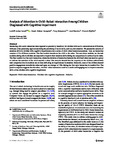Analysis of Attention in Child–Robot Interaction Among Children Diagnosed with Cognitive Impairment
| dc.contributor.author | Ismail, LI | |
| dc.contributor.author | Hanapiah, FA | |
| dc.contributor.author | Belpaeme, Tony | |
| dc.contributor.author | Dambre, J | |
| dc.contributor.author | Wyffels, F | |
| dc.date.accessioned | 2020-07-09T11:10:18Z | |
| dc.date.available | 2020-07-09T11:10:18Z | |
| dc.date.issued | 2020-02-03 | |
| dc.identifier.issn | 1875-4791 | |
| dc.identifier.issn | 1875-4805 | |
| dc.identifier.uri | http://hdl.handle.net/10026.1/15926 | |
| dc.description.abstract |
Interacting with social robots has been reported as potentially beneficial for children with social communication difficulties, with one of the promising applications being the practising of social skills, such as joint attention. We present the analysis of attention skills in children with cognitive impairments over a series of child–robot interaction sessions. Here, an interaction consists of five different modules. The first module introduces the child to the robot. The next three modules are the task modules during which children are expected to improve their attention skills during the completion of a series of social tasks. The final module is a free style interaction, where the duration of interaction between the child and robot was used as a proxy to indicate the attention of the child towards a robot. Our analysis showed that the majority of the children reduced their task completion time in modules two to four, indicating an improvement in attention. Moreover, most of the children showed positive engagement towards the robot and spent an average of 120 s during the free style interaction in module five. The positive response suggests that the robot, via child–robot interaction could be a useful and engaging tool to improve attention skills of the children with cognitive impairment. | |
| dc.format.extent | 141-152 | |
| dc.language | en | |
| dc.language.iso | en | |
| dc.publisher | Springer Science and Business Media LLC | |
| dc.subject | Child-robot interaction | |
| dc.subject | Children with cognitive impairment | |
| dc.subject | Robotics | |
| dc.title | Analysis of Attention in Child–Robot Interaction Among Children Diagnosed with Cognitive Impairment | |
| dc.type | journal-article | |
| dc.type | Journal Article | |
| plymouth.author-url | https://www.webofscience.com/api/gateway?GWVersion=2&SrcApp=PARTNER_APP&SrcAuth=LinksAMR&KeyUT=WOS:000515820300001&DestLinkType=FullRecord&DestApp=ALL_WOS&UsrCustomerID=11bb513d99f797142bcfeffcc58ea008 | |
| plymouth.issue | 2 | |
| plymouth.volume | 13 | |
| plymouth.publication-status | Published | |
| plymouth.journal | International Journal of Social Robotics | |
| dc.identifier.doi | 10.1007/s12369-020-00628-x | |
| plymouth.organisational-group | /Plymouth | |
| plymouth.organisational-group | /Plymouth/Faculty of Science and Engineering | |
| plymouth.organisational-group | /Plymouth/Research Groups | |
| plymouth.organisational-group | /Plymouth/Research Groups/Marine Institute | |
| plymouth.organisational-group | /Plymouth/Users by role | |
| dcterms.dateAccepted | 2020-01-22 | |
| dc.rights.embargodate | 2021-2-2 | |
| dc.identifier.eissn | 1875-4805 | |
| dc.rights.embargoperiod | Not known | |
| rioxxterms.versionofrecord | 10.1007/s12369-020-00628-x | |
| rioxxterms.licenseref.uri | http://www.rioxx.net/licenses/all-rights-reserved | |
| rioxxterms.licenseref.startdate | 2020-02-03 | |
| rioxxterms.type | Journal Article/Review |


